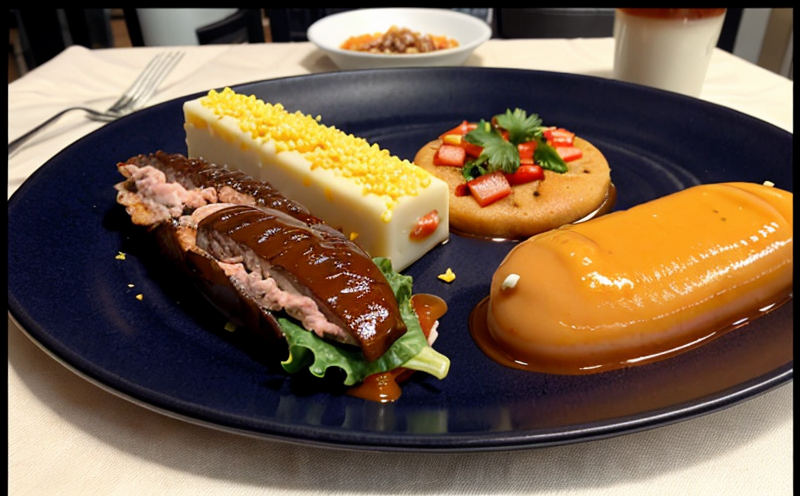EN 1186-3 Overall Migration in Aqueous Food Simulants
The European standard EN 1186-3 specifies the method of determining overall migration from packaging materials into food simulants. This testing is crucial for ensuring that any substances migrating into contact with food do not pose a risk to human health. The standard applies to various types of packaging, including films, sheets, containers, and closures used in the packaging industry.
The test involves submerging the packaging material in aqueous food simulants under specified conditions and then analyzing the extractable substances using appropriate analytical methods such as gas chromatography-mass spectrometry (GC-MS) or high-performance liquid chromatography (HPLC). The overall migration limit (OML) is calculated based on the concentration of extracted components, which must not exceed predefined values set by national regulations.
Food contact packaging plays a critical role in protecting food products during storage and transportation. However, it is essential to ensure that any materials used do not transfer harmful substances into the food. This test helps manufacturers comply with regulatory requirements and safeguard consumer health.
The standard provides detailed procedures for preparing samples, conducting the migration test, and interpreting results. It also includes acceptance criteria that define when a packaging material passes or fails the test based on its overall migration limits.
For instance, in an aqueous food simulant like water at 20°C, the overall migration limit can be set to ensure no more than 10 mg/dm² of extractable substances are present. This value is derived from risk assessments conducted by regulatory bodies and reflects a balance between practicality and safety.
The testing procedure typically involves several steps:
- Preparation of the packaging sample according to specified dimensions and surface area.
- Submerging the prepared sample in the aqueous food simulant at 20°C for a defined period (usually 5 days).
- Removing the sample from the simulant, rinsing it thoroughly, and drying it before analysis.
- Analyzing the extractable substances using GC-MS or HPLC to determine their concentration.
- Calculating the overall migration based on the measured concentrations and comparing them against the OML.
The results of this test are critical for ensuring compliance with national regulations, such as those in the European Union. Compliance is not just a legal requirement but also an essential step towards maintaining consumer trust and safety.
Understanding the overall migration process helps quality managers, compliance officers, R&D engineers, and procurement teams make informed decisions about packaging materials. By adhering to this standard, they can ensure that their products meet high-quality standards and protect public health.
Applied Standards
The EN 1186-3 method is widely recognized for its accuracy and reliability in assessing overall migration from packaging materials into food simulants. This standard has been adopted by various countries across Europe, including the United Kingdom, Germany, France, Italy, Spain, and others.
Other related standards include:
- EN 12358: Determination of the Migration of Substances from Packaging into Foodstuffs
- ASTM D7091-16: Standard Practice for Determining the Migration of Extractable Substances from Plastic Film and Sheeting into Aqueous Food Simulants
- ISO 15123-1: Plastics—Determination of Migratable Substances into Foodstuffs—Part 1: General Principles and Methods
The application of these standards ensures consistency in testing procedures, which is essential for maintaining the integrity of food safety regulations.
Environmental and Sustainability Contributions
Compliance with EN 1186-3 not only enhances food safety but also contributes positively to environmental sustainability. By ensuring that packaging materials do not leach harmful substances into food, this standard helps reduce the risk of contamination and waste generation.
- Reduction in Environmental Impact: Packaging with controlled migration limits minimizes the need for excessive packaging, which can lead to reduced waste and lower carbon footprints.
- Consumer Confidence: Meeting this standard builds trust among consumers who are increasingly concerned about the environmental impact of products they purchase.
- Regulatory Compliance: Adherence to EN 1186-3 ensures that packaging manufacturers meet legal requirements, avoiding potential fines and legal action.
Incorporating this standard into product development processes can lead to more sustainable practices throughout the supply chain. This includes selecting eco-friendly materials for packaging while maintaining safety standards.
Competitive Advantage and Market Impact
Meeting EN 1186-3 standards offers significant competitive advantages in the global market, particularly within industries reliant on food safety compliance and sustainability. Adherence to these standards demonstrates a commitment to quality and consumer protection, which can enhance brand reputation and customer loyalty.
Companies that excel at packaging safety are better positioned to meet increasing demand for safer products, especially as regulatory bodies continue to tighten controls over packaging materials. This is particularly relevant in regions where strict food safety regulations are enforced.
The ability to offer compliant products allows businesses to expand into new markets and gain a competitive edge over those that do not meet the same standards. Compliance also helps reduce potential liabilities associated with non-compliance, thereby protecting company assets and reputation.





